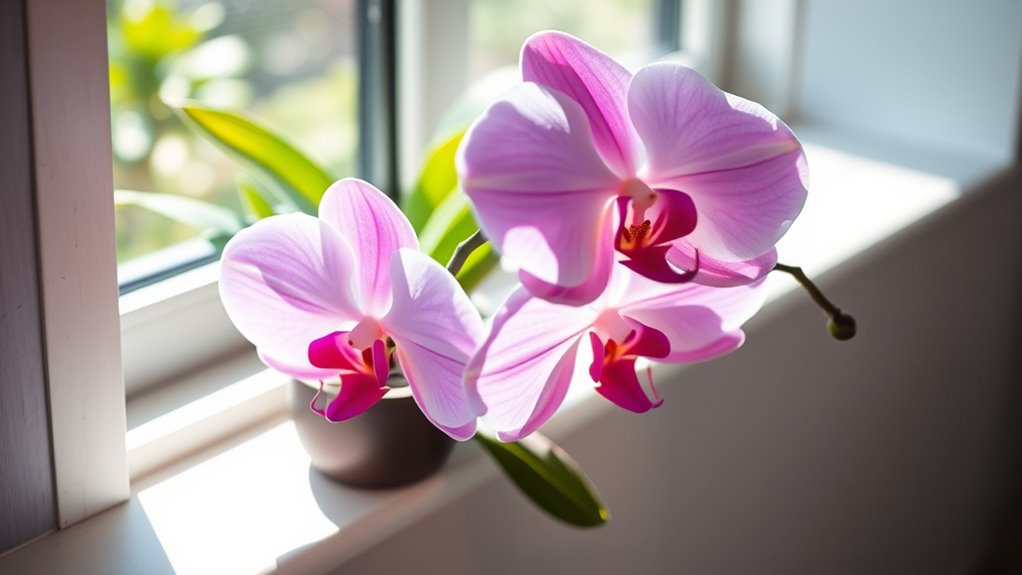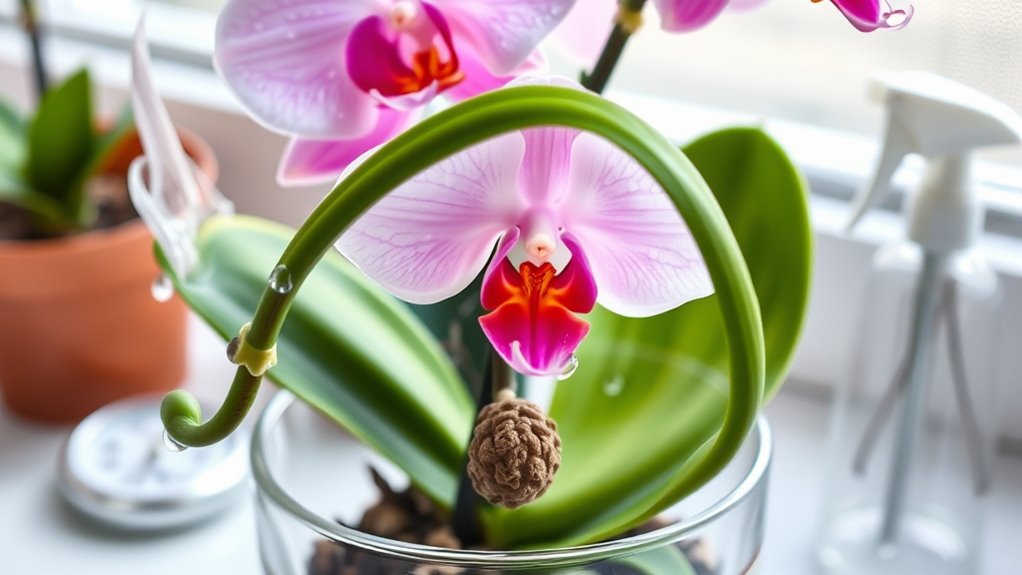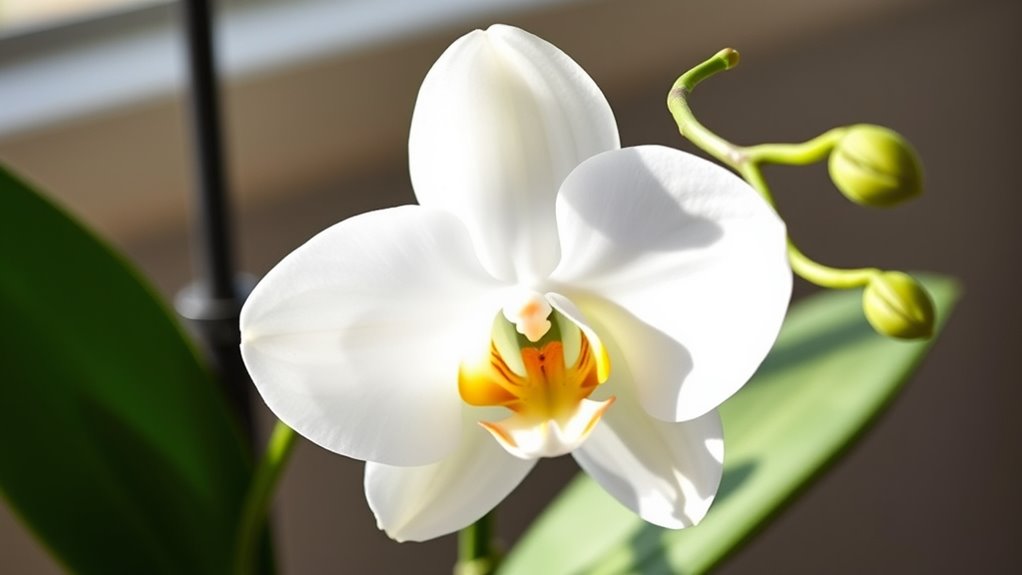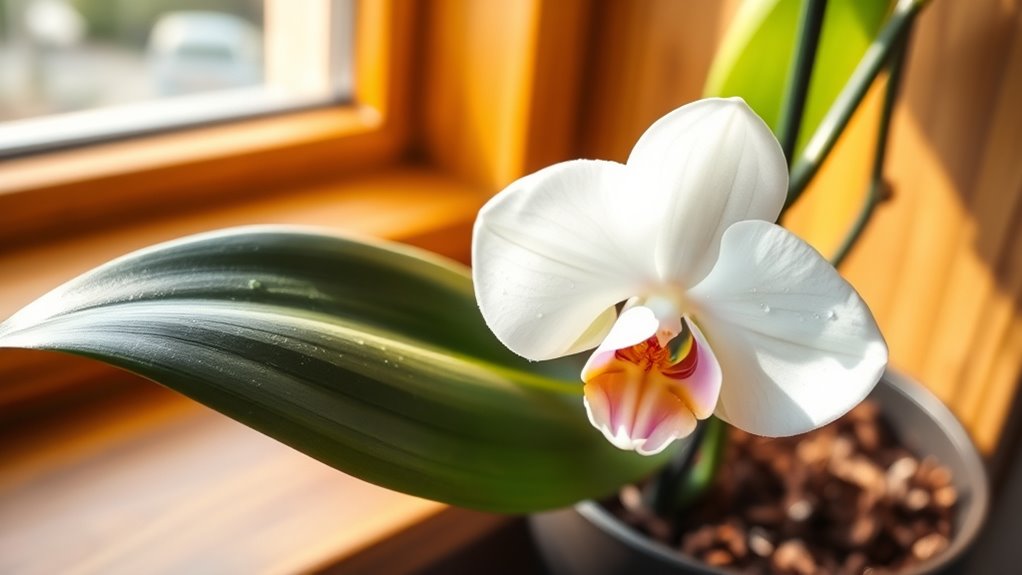To keep your Phalaenopsis orchid alive, place it near bright, indirect light, like an east-facing window, and avoid direct sun to prevent leaf scorch. Water once a week when the potting media feels dry, and increase humidity with a pebble tray. Support flower stalks to encourage reblooming, trim spent spikes, and inspect regularly for pests or disease. Proper re-potting, fertilizing, and airflow also help your orchid thrive—there’s more to uncover for long-term success.
Key Takeaways
- Provide bright, indirect light (10,000-16,000 lux) and avoid direct sun to prevent leaf scorch.
- Water weekly, ensuring the media feels just dry, and increase humidity with a pebble tray.
- Support flower stalks early and cut faded spikes just above the base to encourage reblooming.
- Regularly inspect for pests, maintain good airflow, and quarantine new plants to prevent diseases.
- Re-pot every 1-2 years with fresh, well-draining media, and fertilize with balanced orchid fertilizer.
Understanding Your Orchid’s Light and Placement Needs

To guarantee your orchid thrives, understanding its light and placement needs is essential. Your Phalaenopsis orchid prefers bright, indirect sunlight, ideally around 800-1,500 footcandles or 10,000-16,000 lux. An east-facing window offers gentle morning light that’s perfect for these orchids, while south-facing windows may require sheer curtains to prevent leaf burn. Direct sunlight can scorch leaves, causing dark patches or translucence, so monitor leaf health closely. Use a light meter or perform a shadow test—if your shadow appears blurry, your light level is just right; a sharp shadow indicates too much direct sun. Additionally, maintaining consistent light conditions fosters healthy growth and blooming, making your orchid happy and vibrant. Ensuring proper orchid watering routines also plays a vital role in keeping your plant healthy and beautiful.
Proper Watering and Humidity Strategies

Proper watering and humidity are key to keeping your orchid healthy. Water your Phalaenopsis once a week, ensuring the potting media feels just dry to the touch before watering again. Use the moisture level of sphagnum moss or the weight of the pot to determine when to water; a dry moss or a lightweight pot indicates it’s time. Proper watering prevents overwatering, which can harm the orchid roots and leaf health. To boost humidity, place a tray of pebbles and water beneath the plant, making sure the pot doesn’t sit directly in water. Maintain indoor humidity levels between 40-50%, or up to 80-90% with good airflow. Use a hygrometer, like the AcuRite 00613, to monitor humidity and adjust with water trays or humidifiers as needed. Additionally, understanding the importance of proper air circulation can help create an environment that supports your orchid’s health. Consistent watering routines and environmental conditions are essential for long-term orchid vitality, especially as sustainable practices become more emphasized in plant care. Incorporating automation in environmental controls can further assist in maintaining optimal conditions for your orchids.
Managing Flower Stalks and Encouraging Re-Blooming

After ensuring your orchid is well-watered and humidity levels are stable, focus on managing its flower stalks to encourage reblooming. Monitor the flower stalks closely and gently support them early to prevent snapping. Incorporate good lighting by positioning your orchid near a window with light opposite the stalk to encourage healthy growth. Once the flowers fade, cut the flower spike about an inch above the orchid’s base to promote reblooming. Before guiding new flower spikes, wait for one to emerge from the base, then train it to grow at a 90-degree angle from the plant, guiding it upward for better appearance and support. Regularly check and support long flower stalks, ensuring they grow strong and upright, which helps boost the chances of a successful rebloom. Additionally, maintaining proper orchid care can significantly improve your plant’s ability to rebloom successfully. Proper watering techniques and consistent care routines are essential for optimal flowering cycles. Providing adequate nutrients through appropriate fertilization also plays a vital role in encouraging new blooms and healthy growth.
Preventing and Addressing Common Pests and Diseases

Regularly inspecting your orchid for pests like scale, mealybugs, spider mites, and aphids is essential for maintaining a healthy plant. Look for signs such as brown bumps, cottony webs, or tiny indentations. If you spot pests, use sterilized tools and treat with insecticidal soaps or horticultural oil to eliminate them at each stage. Remove and discard infected plant parts immediately to prevent secondary infections and fungal issues. Good airflow, achieved with fans or open windows, helps reduce humidity that fosters pests and fungal infections. Incorporating mindfulness practices such as mindful observation can help you become more attentive to subtle changes in your plant’s condition. Enhancing your understanding of credit card insights can also support your budget for plant care supplies, ensuring you have the necessary resources for treatments. To prevent virus transmission, avoid sap contact and insect vectors, and quarantine new or infected plants. Implementing AI-driven diagnostic tools can aid in early detection of plant pests and diseases, making prevention more effective. Consistent plant inspection and prompt treatment are key to preventing pests from spreading and maintaining your orchid’s health.
Re-Potting, Fertilizing, and Maintaining Healthy Roots

To keep your orchid healthy, you need to re-pot it every 1-2 years using sterilized tools and fresh media like bark or sphagnum moss. This process promotes healthy roots, prevents root rot, and guarantees proper drainage. Proper re-potting also helps roots stay properly anchored, facilitating oxygen exchange and overall vitality. Regularly inspecting roots and maintaining optimal conditions can help prevent issues such as root rot and ensure your orchid thrives. Using appropriate soil media can further enhance drainage and aeration, supporting healthy root development. Incorporating vertical storage solutions can also help keep your orchid area organized and accessible, reducing clutter that might impact plant care.
Frequently Asked Questions
How Do You Take Care of a Phalaenopsis Orchid for Beginners?
To take care of your Phalaenopsis orchid, place it near an east-facing window with bright, indirect light.
Water it when the potting medium feels barely dry, usually weekly, and keep humidity around 50-70%.
Fertilize every 2-3 weeks with a diluted orchid fertilizer.
After blooming, prune the flower spike and re-position the plant for continued healthy growth.
Re-pot every 1-2 years to refresh the medium and support re-blooming.
How Do You Keep a Phalaenopsis Orchid Alive?
To keep your Phalaenopsis orchid alive, you need to focus on proper watering, light, and humidity.
Water only when the roots feel dry, using a well-draining mix.
Provide bright, indirect light for at least six hours daily, and keep humidity levels between 40-70%.
Regularly inspect roots in transparent pots, removing any dead or rotting ones, and repot when the medium breaks down.
Consistent care guarantees your orchid thrives.
Where Is the Best Place to Put a Phalaenopsis Orchid?
You should place your Phalaenopsis orchid near an east or west-facing window where it gets bright, indirect light. Keep it away from direct sunlight, especially during the hottest parts of the day, to prevent leaf scorch.
A stable, consistent spot with filtered light, like behind a sheer curtain or on a shaded windowsill, creates ideal conditions. This helps your orchid stay healthy and encourages beautiful blooms.
How Do I Keep My Phalaenopsis Orchid Blooming?
Think of your orchid as an artist waiting for the perfect moment to showcase its masterpiece. To keep your Phalaenopsis blooming, give it bright, indirect light near east-facing windows.
After flowers fade, trim the spike to encourage a new show. Feed it every 2-3 weeks with balanced fertilizer, maintain humidity around 50-70%, and keep temperatures between 65-75°F.
With patience and care, your orchid will continue to dazzle season after season.
Conclusion
With patience and gentle care, your orchid will flourish like a delicate symphony in full bloom. By understanding its needs and nurturing it with consistent attention, you’ll watch your Phalaenopsis thrive, its flowers unfurling like whispers of elegance. Think of your plant as a living masterpiece—each act of care adding vibrant strokes to its canvas. Keep tending, and soon, your orchid will reward you with a breathtaking display, a tribute to your dedication and love.









